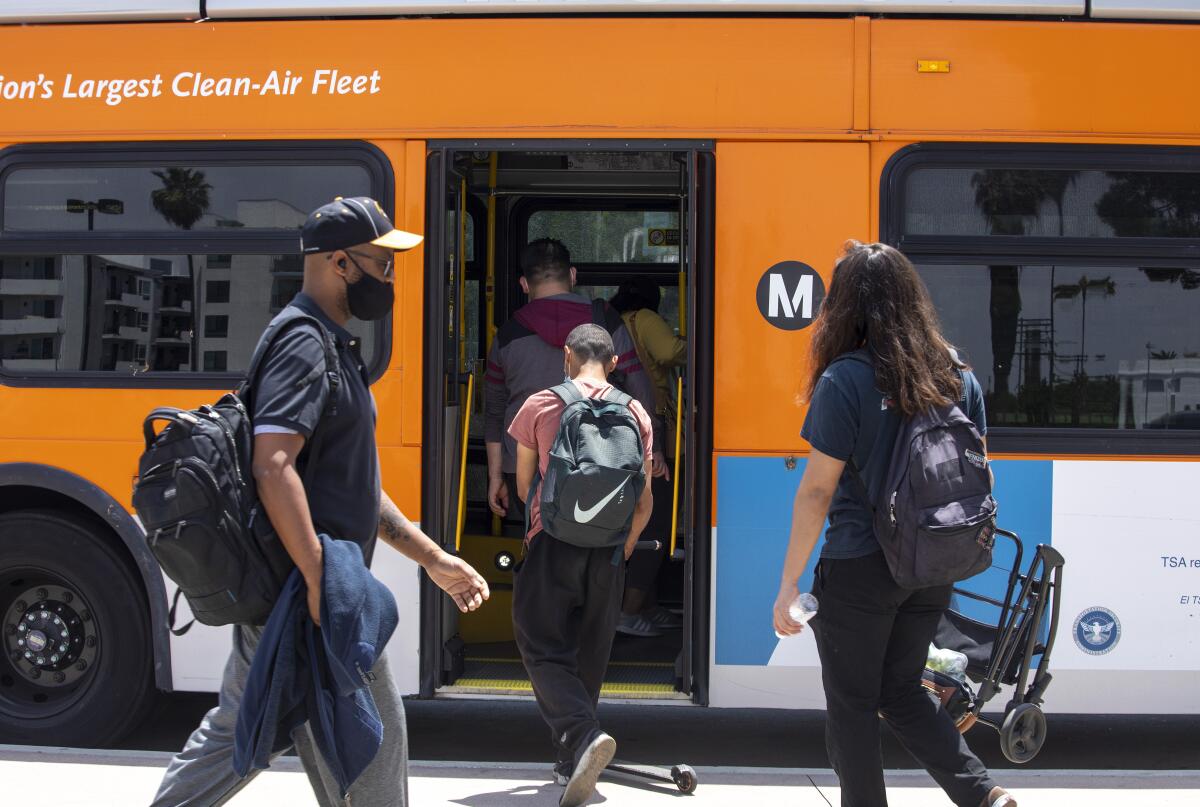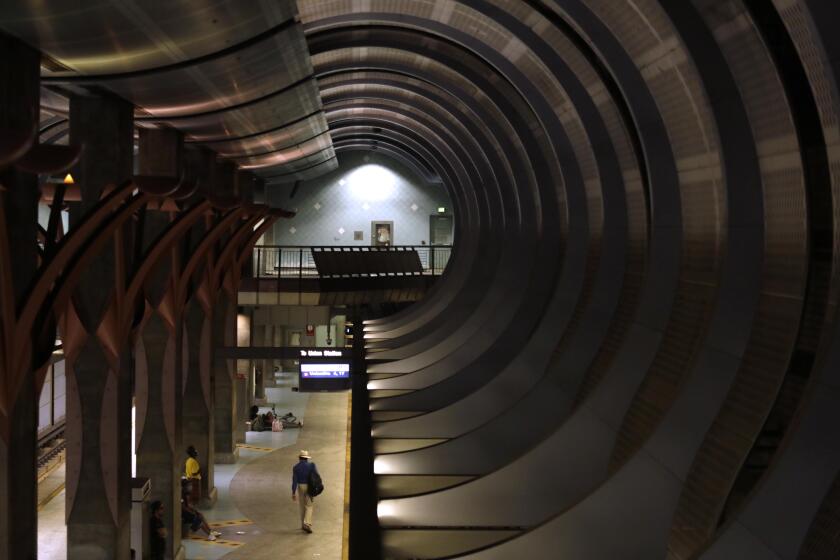Opinion: Here’s why L.A.’s Metro system should let everyone ride for free

- Share via
As the name implies, public transit is a public good for which everyone should split the bill, no matter how often they use it. In fact, everyone in Los Angeles already pays: Metro, Los Angeles County’s largest public transit agency, collects most of its approximately $9-billion annual budget through sales taxes and state and federal funding programs.
But by collecting fares on top of this public funding, Metro penalizes those who use the system — people who need it the most and earn the least — without yielding much for its riders. At the Metro board meeting on Thursday, it’s time to take seriously the need for permanent fareless transit.
For many Metro riders, fares are a significant portion of their household expenditures. As outlined in a recent report from Strategic Actions for a Just Economy, co-published with us at the Alliance for Community Transit-Los Angeles, about 63% of Metro riders earn less than $25,000 annually. For the 40% who earn less than $15,000, annual fares can constitute about a month of their earnings.
Buses aren’t safer because their rubber tires act like crime-fighting vigilantes. Most likely they’re safer because more people use them.
How crucial are these fares for Metro? This year, the agency expects them to bring in $146.8 million, 1.7% of its overall proposed budget.
Compared with the budgets of other major transit agencies, that’s peanuts. New York’s Metro Transit Authority, for example, generates nearly 25% of its budget from fares (and that’s down from 42% pre-pandemic). The D.C.-area transit agency, which is pursuing a permanent fareless bus program, generates around 6%.
In L.A., evidence has mounted in favor of fareless transit. The city ran a successful fareless bus program for almost two years of the pandemic. Internal studies identified multiple benefits to eliminating fares. Residents, including more than 80% of riders surveyed by Metro, back the idea. Yet in response to demands for fareless service at a November public hearing, Metro staff asserted that they cannot find the funding.
If Metro cannot think of a way to account for 1.7% of its budget, then the agency’s problem is a lack of perspective, not of funds.
Consider the potential savings of ditching fares: 2023 numbers indicate that Metro astonishingly spends nearly 75% of its fare revenue to maintain and enforce fare collection. It approves billions of dollars for highways and roads, despite widespread acknowledgment that we need to drive less to combat the climate and traffic violence crises — both of which disproportionately affect communities of color. The agency authorizes spending $150 million-$200 million annually to contract police without interrogating law enforcement’s effect on crime and rider safety, including dangerous targeting of Black and brown riders. And it prioritizes expensive rail projects, catering to tourists and higher-income professionals, over bus service investments that would benefit all riders, particularly those who depend on transit the most.
Fareless opponents often claim that Metro cannot eliminate fares because it would inflict devastating cuts on already austere operational budgets, or that inflexible earmarks for capital expenses make it difficult to reconfigure spending.
Disorder, rising crime and declining confidence not only pose an existential crisis to the Metro system but also to the region’s climate, sustainability and livability goals.
That shortsighted view is precisely the problem. If some revenue streams are too restrictive, the agency should get creative with the discretionary funds it does have and take a closer look at the budget for spending that doesn’t benefit riders or the system. If necessary, Metro can seek to remove earmarks, restructure funds or raise more money through the ballot box and state and federal advocacy.
Whatever the challenges of a universal fareless system, there is no more efficient policy to simultaneously address the climate crisis, public safety and equity. It would help reduce local vehicle miles traveled. It’s a proven strategy to increase public transit ridership, which would bring more eyes to promote safety in the system. It would eliminate tense exchanges between bus operators and riders over fares, enabling operators to focus on being safe drivers (rather than cashiers and gatekeepers). And as shown by the city’s previous fareless program, the most economically burdened riders would reduce their household’s costs, experience less stress and have greater mobility overall.
Metro should be understood not as a business that delivers transit for a price, but as a public service that listens to, and invests in, community. No longer would precious Metro staff and board time, community outreach efforts and funds be expended on scrutinizing and scaffolding an ineffective fare system. A new approach could free up public dollars and time to invest in care-based public safety, Metro’s operators and workers, and bus service improvements.
Crucially, a universal fareless transit policy would convey to Metro’s most loyal riders that they are finally heard and seen.
Yotala Oszkay Febres-Cordero is a researcher with the Alliance for Community Transit - Los Angeles, a Leading Edge Fellow with the American Council of Learned Societies and an economic and political sociologist.
More to Read
A cure for the common opinion
Get thought-provoking perspectives with our weekly newsletter.
You may occasionally receive promotional content from the Los Angeles Times.












